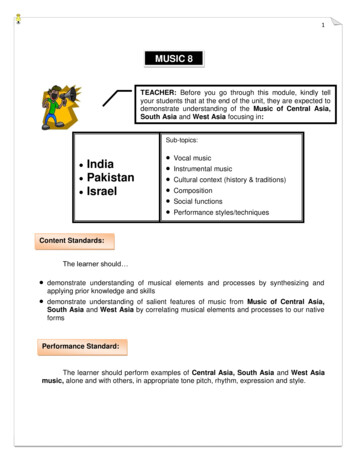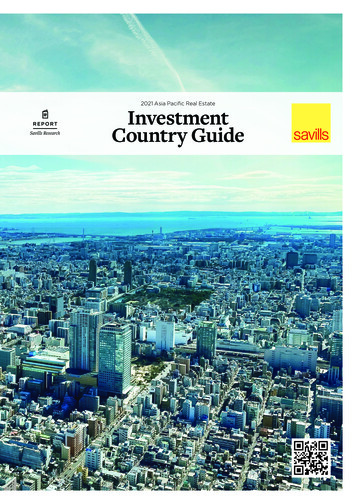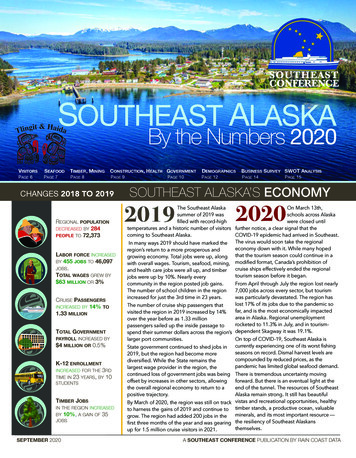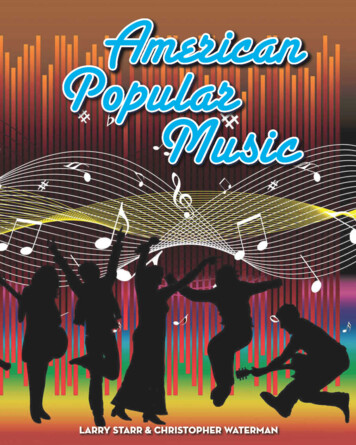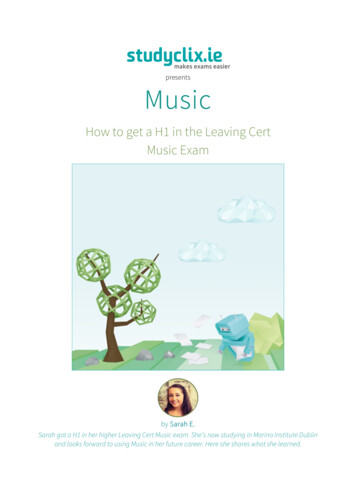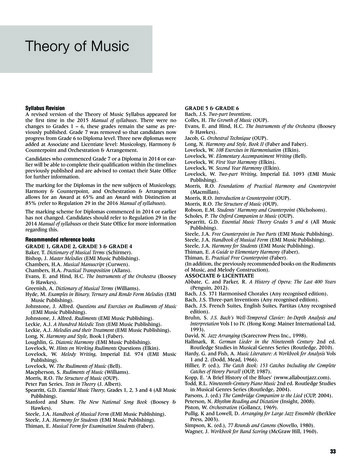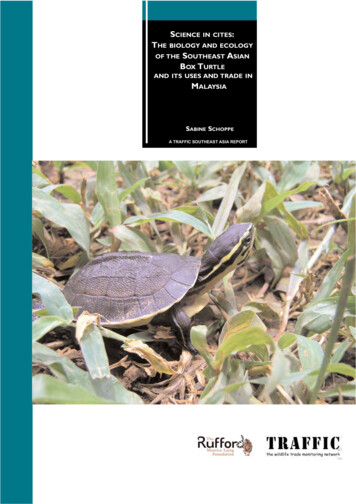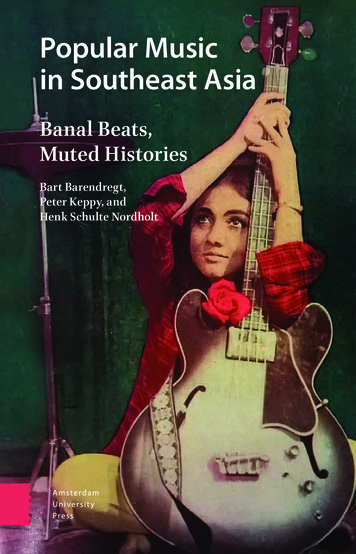
Transcription
Popular Musicin Southeast AsiaBanal Beats,Muted HistoriesBart Barendregt,Peter Keppy, andHenk Schulte Nordholt
Popular Music in Southeast Asia
Popular Music in Southeast AsiaBanal Beats, Muted HistoriesBart Barendregt, Peter Keppy, and Henk Schulte NordholtAUP
Cover image: Indonesian magazine Selecta, 31 March 1969KITLV collection. By courtesy of Enteng TanamalCover design: Coördesign, LeidenLay-out: Crius Group, HulshoutAmsterdam University Press English-language titles are distributed in the USand Canada by the University of Chicago Press.isbne-isbndoinur978 94 6298 403 5978 90 4853 455 5 (pdf)10.5117/9789462984035660Creative Commons License CC BY NC ND All authors / Amsterdam University Press B.V., Amsterdam 2017Some rights reserved. Without limiting the rights under copyright reservedabove, any part of this book may be reproduced, stored in or introduced intoa retrieval system, or transmitted, in any form or by any means (electronic,mechanical, photocopying, recording or otherwise).
Table of ContentsIntroduction 9Muted sounds, obscured histories 10Living the modern life 11Four eras 13Research project Articulating Modernity 151 Oriental Foxtrots and Phonographic Noise,1910s-1940s 17New markets 18The rise of female stars and fandom 24Jazz, race, and nationalism 28Box 1.1 Phonographic noise 34Box 1.2 Dance halls 34Box 1.3 The modern woman 362 Jeans, Rock, and Electric Guitars, 1950s-mid-1960s Youth culture Moral indignation Local industry Beat goes local Box 2.1 Gangs Box 2.2 Blue Jeans Box 2.3 Tremolo guitar 39404445475151523 The Ethnic Modern, 1970s-1990s 55Modern music for the Muslim Malay masses 55Pop history, as we know it 58Subversive sounds 61Making noise in the big melting pot 64What is so modern about the ethnic? 66The sound of longing for home: pop Minang 69Village girl and big city pop diva: The story of EllyKasim 71
Box 3.1 Disco 73Box 3.2 Dangdut 74Box 3.3 Going abroad (in two songs) 754 Doing it Digital, 1990s-2000s Musical revolutions: Finally indie-pendent? Pop, politics, and piety Asia around the corner Doing it Digital: Three apparent paradoxes The Malay Muslim girl-next-door: A deeper conversation with Yuna Box 4.1 JKT48 Box 4.2 An Indonesian indie song Box 4.3 Karaoke discs Box 4.4 SoundCloud communities Selected Bibliography 79808487909396979798101List of Illustrations1 A Malay dondang sayang song recorded inSingapore by Pagoda Record, subsidiary of DeutscheGrammophon, c. 1935 2 Quranic text interpretation (tafsir) and translationfrom Arabic to Malay by a female religious expert(ustazah) recorded by Extra Records (His Master’sVoice) in Indonesia, c. 1938 3 Rajuan Irama, an Malay orchestra, c. 1935 4 Two Europeans dressed Filipino-style representing‘Manila Jazz’, Indonesia, c. 1920s 5 Modern jazz music was also regularly associatedwith noise, as evidenced by this advertisementfor a medicine to combat headaches. Published inperiodical D’Orient, Netherlands East Indies, 1936 2224272933
6 Eurasian Malay opera actor, playwright, director,singer and popular recording artist, P.W.F. Cramer,accompanied by a Malay opera leading lady (sripanggung) from Betawi (present-day Jakarta),standing next to a phonograph equipped with agiant horn, c. 1912 347 Indonesian popular singer Dinah in modern dressand hair fashion, c. 1938. She engaged successfullyin kroncong singing competitions in Singapore from1937 onwards, recorded for HMV in Singapore, andappeared on radio in the Netherlands East Indies in1940. 378 Brilliantine was an indispensable product for men inthe 1950s. It kept the hair well-groomed and gave itthe shine. 419 New American dances were tried on the dance floorat social gatherings such as at this Bandung highschool party, c. 1957. 4310 Fashion-conscious Bandung youth sporting tightjeans, c. 1957 5311 Radio Prambors was launched in 1971 in Jakarta.Airing pop music, Prambors was a teen icon in the1970s-1990s period. Nowadays, Prambors FM isIndonesia’s ‘No. 1 Hit Music Station’. 7612 Sumatran punk youth, 2008 8213 Video CD vendor in a market stall 9814 #SoundCloud Meetup YK in the Momento Café,Yogyakarta, 26 February 2014 99
IntroductionNot bound by national borders, popular music has been flowingacross the world for over a century. It has been consumed andproduced by many, including Southeast Asians. This book offersa concise history of popular music and its social meaning inSoutheast Asia. It focuses on the Malay world; that is, present-dayIndonesia, Malaysia, and Singapore, with an occasional sidestepto other parts of the region, such as the Philippines and Thailand.The period stretches from popular music’s beginnings in the ‘JazzAge’ of the 1920s and 1930s, to the first decade of the twenty-firstcentury, with phenomena such as modern Muslim boy bandsand digital music sharing.Popular music matters. Besides offering people leisure, it alsohas deeper social meaning, and this deserves to be studied. Themain thread of this book is how locally produced popular musiccame into being as a token of modern life, and as a terrain wherepeople, performers, and audiences enjoyed as well as reflected onboth the blessings and downsides of modern life in the twentiethcentury.Each generation has its stock of cultural heroes and favouritepopular tunes. For example, in the 1920s and 1930s the Javanese singer-actress Miss Riboet was one of the most popularperformers in island and peninsular Southeast Asia and thefirst trans-local female celebrity in the Malay world. Her famereached from Penang to Manila. She performed and recorded ongramophone an eclectic song repertoire from Javanese folk tunesto Arabic songs. In more recent times, the popular boy bandRaihan attracted large crowds in Malaysia and Indonesia duringthe first decade of this century. Guided by beliefs on Islamicpiety, moral purity, and facilitated by the latest in recordingtechnologies, and admired by the rising orthodox middle classesand Muslim activists alike, Raihan merged Western popularmusic with Malay and Arabic music styles. 9
Miss Riboet and Raihan may be separated in time by morethan f ifty years, they have in common to have married theold with the new and to have connected local traditions withforeign cultural forms. In doing so, they transformed music intosomething that people conceived as novel and modern, yet at thesame time as sufficiently recognizable. Moreover, their songscontained moral lessons, albeit based on different convictions,aimed at educating listeners in order to improve the humancondition and to achieve a just society. While Riboet took asecular position, for Raihan religion was clearly a starting point.It is this mix of popular music’s novelty and social relevance thatappealed to large groups of people.Muted sounds, obscured historiesWe must bear in mind that, in spite of its long and persistentpresence, popular music is ill-defined. The term ‘popular’ originally designated the notion of ‘belonging to the people’, but hasbeen used pejoratively to mean ‘low’ or vulgar culture. Suchqualifications indicate that the cultural and social meaning ofthe popular is questioned and even contested. A more neutralmeaning is that of ‘widely appreciated’, and ‘away from a topdown perspective’, referring to people’s own views. The term isalso associated with the spread of mass media. Yet, such takenfor-granted connotations and generalizations tell us little aboutwhat popular music contained or meant to people in specifictimes and places. Popular music has been treated as trivial andbanal. Its performers are often muted, and music-loving publicsignored. To gain an understanding of the meaning of popularmusic, it needs to be contextualized. Popular Music in SoutheastAsia situates popular music in the specific socio-historical settings of Southeast Asia’s cosmopolitan urban centres.We can search historical textbooks in vain for mention of popular stars like Miss Riboet and Raihan, their careers, their songsas well as their audiences. Their social and cultural significance10
has largely escaped academic attention. This is no doubt due todeeply ingrained elitist preconceptions of pop music as vulgarand meaningless entertainment for the masses, not worthy ofstudy. Moreover, readings of the past that emphasized the nationand national cultural identity have subdued if not obscured thecross-border practices of innovative actors and their audiences.Hybrid popular music tends to blur or even challenge nationalidentities, rather than enhance or consolidate them. Hence,popular culture habitually becomes the subject of discussionand confusion or, in the case of nationalist historiography, mighteven evoke opposition or even historical amnesia.The publication Dance of Life (1998) by American historianCraig A. Lockard stands out as one of the few attempts to seriously consider Southeast Asian popular music as a political,social, and cultural force in its own right. Lockhard’s project wasgeared heavily towards popular music as a channel of politicalprotest for Southeast Asian artists under post-colonial authoritarian regimes. Popular Music in Southeast Asia expands on hispioneering work while taking on the dynamic interplay betweenaudiences, artists, and the culture industry. Its focus is on thelure of modernity in post-colonial as well as colonial settings.The elusive phenomenon of modernity can be understoodas a set of ideas about or even desire for the new, progress,individual choice, innovation, and social and cultural change.Modernity tells us how people thought about and dealt withlife in a changing urban environment. Due to its innovative,hybrid, and cross-border nature, popular music, par excellence,has solicited discussions in Southeast Asia about what pertainsto modern life.Living the modern lifeSoutheast Asia’s centuries-long history of trade, labour migration,and cross-cultural encounters in cities such as Singapore, KualaLumpur, Jakarta, Bangkok, and Manila yielded highly diversified 11
urban populations and hybrid cultures. For centuries, commercial trading networks linked the region to China, India, theMiddle East, and, during the heydays of colonialism, to Europeand America. Locally rooted migrant communities – Chinese,Arab, Tamil – emerged and mixed with the native population.It is therefore no surprise that these surroundings formed thebreeding ground for a hybrid popular culture, including popularmusic and related modern lifestyles of which the outlines dawnedin the early twentieth century. Increased capitalist penetrationof and far-reaching colonial intervention into local SoutheastAsian societies are rooted in the late nineteenth century. It wasin the twentieth century, however, that the side effects of theseexternal interventions surfaced more visibly. This is attestedto, for example, in the emergence of a multi-ethnic urban andWestern-educated ‘middle class’. Its members earned theirmoney from white-collar professions in the colonial administration, in the expanding commercial agricultural sector, andin the service sector. No less attracted to modernity than theworking classes, these relatively affluent people simply had moremoney to spend. Moreover, they appeared more inclined towardsa Western-oriented lifestyle that helped them to distinguishthemselves from the working class as well as from the nativearistocratic elites. With the introduction of new, cheaper mediatechnologies in the second half of the twentieth century, likethe transistor radio and the audio cassette player, the face ofmass consumption altered dramatically. Media technologiesbecame available to larger sections of the less well-to-do sections of society, also outside the cosmopolitan urban centres.These technological changes were of great significance for thedevelopment of the culture industries and for the disseminationof popular music in the twentieth century. Needless to say, thedevelopment of digital recording technologies and the internetat the end of the millennium had a similar effect.Rather than seeing consumers of popular music purely interms of middle- and working-class spectatorship, it is moreappropriate to speak of socially differentiated publics in terms12
of generation, gender, peasants to urbanites, ethnic, and religiousgroups. The intriguing aspect of popular music is that particulargenres often appeal to sections of these different groups in society simultaneously. Without suggesting that it has necessarilybeen a uniting or socially harmonizing force, popular musicdoes cross social groups and, at the same time, it allows peopleto rally around it, forming new identities. One explanation forthis capacity or appeal lies in the fact that the new-fangledmusic styles formed part of a larger package called ‘lifestyle’.How such life styles come into being is a complex process ofcultural interaction between producers and consumers. Popularmusic performers, the culture industry, and print media eachin their turn and often working in tandem, provide audiencesmodels fashionable styles, from hairdressing to clothing, codesof conduct, and vernacular languages. The culture industrymight manipulate artists and consumers; the industry cannotexert absolute power over consumers. Music lovers are not passive consumers. They have their own preferences and ways ofconsuming, and identity is not a thing. Identities are imaginedand given content and meaning by people who often are notinvolved in the culture industry and may even rebel against it. Inshort, popular music offers new means for self-expression and asense of community, fan groups being the best visible example.Four erasThis book is divided into four chapters, each representingpivotal historical junctures: the 1910s to 1940s; the 1950s tomid-1960s; the 1970s to 1990s; and finally, the late 1990s up tothe first decade of the twenty-first century. In these four eras,technological innovation, human agency, the consumption ofnew music styles, and the rise of pioneering artists and newaudiences converge within particular Southeast Asian urbanlocalities. Artists and their audiences together redefined popularculture, surprising, pleasing, but also confusing and annoying 13
others. As they explored artistic, technological, entrepreneurial,and commercial possibilities, artists were put at the forefrontof popular culture’s production. Visible and audible throughthe production and consumption of popular music, they mademodernity manifest in everyday social life.Although some overlap of media technology use occurred, eachof the four different periods is characterized by a concurrenceof new music styles and specific technologies: the gramophone;radio, television, cinema, audio cassettes, CDs, and web-basedtechnologies including YouTube or SoundCloud. And it shouldbe emphasized that throughout the twentieth century, printmedia, especially newspapers, remained important sources forlaunching artists into stardom as well as discussing their workand the modern life styles they seemed to propagate.This book departs from four interlocking sets of questions:(1) Who were the main artists and producers that generatednew forms of popular music? What sort of urban environmentfacilitated the changes they were part of? (2) What was the musiclike? Which genres were moulded into new styles? What didthe music express? (3) Which technologies, ranging from thegramophone to the internet, were appropriated, and how didthese technologies facilitate the dissemination and marketingof new music styles? (4) Who were the audiences of new popularmusic in terms of ethnicity, religion, gender, generation, andclass? How was the music received? Were particular lifestylesarticulated to mark social distinction, and what does this revealabout the relationship between popular culture and society?Following the chronology of the suggested periods, fourchapters are here presented. Chapter 1, ‘Oriental Foxtrots andPhonographic Noise, 1910s-1940s’, deals with the Jazz Age. Itexplores the hybrid nature of a blossoming of popular musicand its new (female) stars, adored and consumed by new urban,middle to upper classes in the Philippines and the NetherlandsEast Indies. Chapter 2, ‘Jeans, Rock, and Electric Guitars, 1950smid-1960s’, traces the emergence of rock and roll, the arrivalof youth culture, rock and roll’s supposedly subversive nature14
and subsequent moral panics, but also the consolidation of alocal music industry in what, by then, were post-independenceMalaysia, Indonesia, and the Philippines. Chapter 3, ‘The EthnicModern, 1970s-1990s’, analyses the rise of ethnic pop in connection with the spread of music cassettes against the backdropof emerging regional identities, and rural urban migration,class consciousness, and an articulation of gender differences.Finally, Chapter 4, ‘Doing it Digital, 1990s-2000s’, observes thenew opportunities and limitations of disseminating popularmusic through the web and other related digital social media.It deals with new sorts of emerging fandom, the construction ofAsian and Muslim pop as trans-national categories, and pointsat the paradoxical and ephemeral nature of the new digital era.Popular Music in Southeast Asia elaborates the complex waysinnovations were embedded into continuities, or how new andold trends were linked. It argues, moreover, that, in order tounderstand the Southeast Asian world of popular music, it isnecessary to shift from an exclusive focus on stardom towards aperspective that includes the everyday practices of the countlessanonymous and, to a large extent, unrecorded performers andtheir publics.Research project Articulating ModernityPopular Music in Southeast Asia: Banal Beats, Muted Historiesis based on the research project ‘Articulating Modernity: TheMaking of Popular Music in Twentieth-Century Southeast Asiaand the Rise of New Audiences (2011-2014)’. This project involvedthe Royal Netherlands Institute of Southeast Asian and Caribbean Studies (KITLV) in Leiden, the NIOD Institute for War,Holocaust and Genocide Studies in Amsterdam, and the Instituteof Cultural Anthropology and Development Sociology of LeidenUniversity. Funding was provided by the Netherlands Organization for Scientific Research (NWO). Articulating Modernity wassupervised by Henk Schulte Nordholt and coordinated by senior 15
researchers Bart Barendregt and Peter Keppy. PhD studentsBuni Yani, Lusvita Nuzuliyanti, and Nuraini Juliastuti, and foursenior visiting fellows, Ariel Heryanto, Philip Yampolsky, AndrewWeintraub, and Tan Sooi Beng, also contributed to the project.Finally, special mention should be made of Emma Baulch, DredgeByung’chu Käng, Azmyl Yusof, Brent Luvaas, James Mitchell,Fritz Schenker, and Jeremy Wallach who through their participation in the workshops organized under the project’s aegis helpedto shape this book.16
1Oriental Foxtrots andPhonographic Noise, 1910s-1940sThe 1920s are known worldwide as the Roaring Twenties or JazzAge. It is a period in between the great world wars when novelforms of commercially driven entertainment emerged, such asthe dance hall, recorded music and film, magazines and serialnovels, and when radio broadcasting was introduced. SoutheastAsia was no exception.Southeast Asia’s Jazz Age tells a story of a vibrant culturalinteraction and social transformation. Popular dance music,such as the Charleston, the foxtrot, tango, and, later, the rumba,the venues and its audiences evoked pleasure as much as debateand controversy. Modern popular dance music led people toquestion and reconstruct boundaries of race, class, nationalidentity, gender, and the modern.Southeast Asians experimented with music, innovatingexisting local genres, making the 1920s and 1930s a period ofdynamic cultural change. Almost as a rule in the region, popularmusic was married to different forms of vernacular theatre. Thetwo started to part company during the almost simultaneousexpansion of the phonographic industry, radio broadcasting andthe advent of sound film (the ‘talkies’) in the late 1920s.This chapter focuses on three themes that highlight the relationship between popular music and society during SoutheastAsia’s Jazz Age: the record industry, the rise of female stars andfandom, and the link between race, nationalism, and popularmusic. When Japan invaded the region in December 1941, andwithin a few months controlled large parts of the area, thesedynamic developments in the realm of popular music weresuspended for the next four years. 17
New marketsBy the turn of the twentieth century, American, and Europeanrecord companies had recognized the commercial prospectsof recording local music in Southeast Asia for local markets.From Burma to Indonesia, local forms of theatre offered a testingground for these first commercial recordings. In 1903, on thefirst phonographic recording expedition for the GramophoneCompany in Asia, recording engineer Fred Gaisberg noted ona trip to Rangoon, Burma, and his encounter with local artists:These bright people have an entertainment called a zat. Thebasis of the drama, which is interspersed with songs and ballet, is the age-old story of a prince and princess. [ ] Poe Seinwas the most popular actor [ ]. His opera company travelledup and down the Irrawaddy River in their own barge andpaddle-steamer, something like the show-boat troupes of theMississippi.Within a few years, many recording expeditions by differentcompanies followed, documenting songs, scenes like comic dialogues taken from Southeast Asian forms of vernacular theatre,such as the Burmese zat, Malay opera and the Hispano-Filipinozarzuela. This symbiosis between vernacular theatre and theforeign gramophone industry formed the basis for the SoutheastAsian entertainment industry to blossom in the 1920s.The local appetite for recorded music gramophones cannotbe understood without acknowledging the profound economicchanges that occurred between the late nineteenth centuryand 1930. In the second half of the nineteenth century, thecolonial economies opened up for private capital. As a result,the commercial agricultural sector expanded, and means oftransportation and infrastructure improved alongside. Modernshipping and new railroad networks linked the rural hinterlandsof peninsular Malaya, Indonesia, and the Philippines to thecoastal trade entrepôts. Between 1900 and 1930, up to the Great18
Depression, the colonial economies boomed. Trade volumesincreased, particularly of commercial crops like sugar. Migrant(plantation) workers flowed from excess labour areas in China,India, and Java to the estates in Sumatra, mainland Malaya, andthe Straits Settlements. The expanding colonial bureaucracies offered new employment opportunities for the native population.The urban-based commerce and service sector expanded as well.Western-style education became available for ‘natives’, althoughnot at all levels and certainly not at a similar pace in all colonies.As a result of these developments, a Western-educated middleclass of government officials, teachers, lawyers, journalists, pettytraders, and small-scale industrialists emerged. This emergingmiddle class covered the political spectrum, from nationalistsactively striving for emancipation and independence to peopleadhering to the colonial status quo. Despite racial divides, economic inequalities, and differences in political loyalties, thisgroup shared a new consumer-oriented lifestyle that set themapart from members of the working class. Their excess incomemade it possible to subscribe to local newspapers and indulgein modern-style consumerism of fashion, music, dance, and toown new consumer items, such as the gramophone player anda radio set.When Fred Gaisberg and the other American and Europeanrecording engineers that followed in his footsteps set foot onSoutheast Asian soil, they knew little about local music andtheatre. They had to rely on local intermediaries from theurban middle class, who could introduce them to performersand inform them about upcoming performances. In Thailand,colonial Indonesia, the Straits Settlements, and Malaya, thesebrokers were often locally based European department storeowners or local Chinese shop owners, who were able to communicate in English or another European language. Some ofthem became local agents for the record companies, otherssubsidiaries recruiting and recording local musicians. The agentssold gramophone players and related equipment from discs toneedles. For many an agent, the music industry was initially a 19
side-line. For instance, between 1905 and 1910, the sole agent forGerman record company Odeon in Singapore was the jewellerLevy Hermanos. Department store Robinson & Co, also operating from Singapore and the sole agent for the Gramophone andTypewriter Ltd., was probably responsible for selling the firstbatch of Malay music recorded by Fred Gaisberg in 1903. In 1906,German record company Beka embarked on a recording ‘expedition’ in Singapore and Batavia, gaining a foothold in Singapore in1907 through department store Katz Bros. Ltd. In 1903, peranakanChinese shop owner Tio Tek Hong, whose core retail businesswas hunting equipment, became sole agent for German recordcompany Odeon in Batavia. One year later, he started releasingrecords under his own name as Odeon’s subsidiary, Tio TekHong Records. He was the first to do so in colonial Indonesia.Around 1903, with the aid of local merchant Kee Chiang & Sonsin Bangkok, the British Gramophone Company Ltd. (His Master’sVoice, HMV) recorded and released what is believed to have beenthe first Siamese records. In 1908, a number of Filipino artistsfrom the Hispano-Filipino zarzuela stage, including the famoussinger-actress Maria Carpena, took part in a recording sessionin Manila for the Victor Talking Machine Company. Several ofthese recordings are songs taken from the Tagalog zarzuela playWalang Sugat (‘No wound’) written in 1902 by Filipino playwrightSeverino Reyes. Unlike other artists in surrounding colonies,Filipinos also travelled to the United States to record. One ofthese earliest known recordings is ‘La Sevillana’, performed byBanda De La Filipina for Victor’s rival in the recording business,Edison, and recorded in New York in 1909.To feed the appetite for locally recorded homegrown musicand theatre plays, the record companies published cataloguesfor potential clientele in Southeast Asia in the local vernacular,in Malay, Thai, and Hokkien. Local agents and subsidiaries of theforeign record companies also advertised in the newspapers fornewly imported and locally recorded songs. Some also offeredpublished song lyric albums and sheet music of local popular music. These printed sources reveal two things. First, that the record20
companies perceived different markets in terms of musical tasteand audiences, and second, that a stylistically hybrid popularmusic that crossed borders was in the making. For example, onerare, surviving Odeon gramophone record catalogue, probablypublished in 1912, indicates that this German company aimedat non-European audiences in colonial Indonesia, Malaya, andthe Straits Settlements (Singapore, Penang, and Malacca). Themusic styles that are represented in this catalogue are hybrid, butthe genres are fixed according to the (alleged) tastes of differentethnic groups, including Chinese migrants and their ethnicallymixed offspring. ‘Chinese music’ is listed separately in Chinesecharacters from the hybrid music produced and consumed bylocally rooted Chinese communities (peranakan or baba). Anexample of the latter is gambang kromong, with origins in theperanakan Chinese community of Batavia (Jakarta). Anotherselection of songs classified under ‘Singapore Malaju records’includes kroncong, a distinct style of string music with originsin Indonesia, and stambul, derived from a form of Malay operaalso with roots in Indonesia. We also find dondang sayang, adistinct musical style popular among Malay-speaking peranakanChinese on both sides of the Straits of Malacca. This ethnicgenre classification seems to have been modelled after the ‘racerecords’ current in the American record industry, designed tocater for specific ethnic groups as niche markets.In the early 1930s, and despite the global economic crisis,the gramophone industry continued to expand in SoutheastAsia. A separation between vernacular theatre and a modernpopular music industry catering for local audiences becamemore pronounced. For example, in 1934, record company HisMaster’s Voice in Singapore secured the services of a young manof Minangkabau origin from West Sumatra, named Zubir Said.Thirty years later, he would be known as the composer of Singapore’s national anthem. As many of the popular musicians at thattime, Said had first worked as a musician in theatres, where hismusic accompanied silent movies. His favourite instrument wasthe violin. Later, he joined an itinerant kroncong band that also 21
Illustration 1 A Malay dondang sayang song recorded in Singapore byPagoda Record, subsidiary of Deutsche Grammophon,c. 1935By courtesy of Jaap Erkelensperformed dondang sayang. Kroncong was a mix of Western andnative music with origins in nineteenth-century Batavia. In the1920s and 1930s, it grew into the most popular genre in the Malayworld. In Singapore, Said became a member of a bangsawan(Malay opera) troupe that performed at the Happy Valley Park,one of the three big amusement parks in the city. In multi-ethnic22
Singapore, Said was exposed to music that was entirely novelto him: Indian and Chinese music, and Dutch songs. When theFilipino band leader of the Malay opera troupe left, Said took hisplace. From there, he moved on from studio recording artist forHMV to recording supervisor and later to the position of talentscout. He personally assessed the vocal qualities of kroncongsingers in Jakarta, Surabaya, Medan, Penang, and Kuala Lumpurand invited them to reco
produced by many, including Southeast Asians. This book offers a concise history of popular music and its social meaning in Southeast Asia. It focuses on the Malay world; that is, present-day Indonesia, Malaysia, and Singapore, with an occasional sidestep to other parts of the region, such as the Philippines and Thailand.
